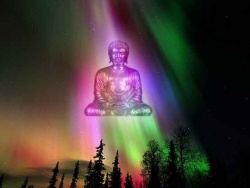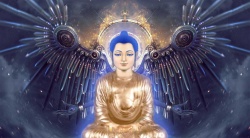Difference between revisions of "Nyingtik"
| (One intermediate revision by the same user not shown) | |||
| Line 1: | Line 1: | ||
<nomobile>{{DisplayImages|3852|4070}}</nomobile> | <nomobile>{{DisplayImages|3852|4070}}</nomobile> | ||
| + | |||
| + | |||
| + | |||
| + | |||
| + | |||
| + | |||
| + | In general [[identical]] with the Instruction Section ([[man ngag sde]]), the third of three [[division]] of [[Dzogchen]]. In particular it refers to the [[Innermost Unexcelled Cycle]] of [[Heart Essence]] ([[yang gsang bla na med pa'i snying thig gi skor]]), [[the fourth]] of the four divisions of the Instruction Section according to the arrangement of [[Shri Singha]]. | ||
| + | All [[lineages]] of the Innermost [[Essence]] passed through [[Shri Singha]] and continued [[in Tibet]] through his personal [[disciples]], [[Padmasambhava]] and [[Vimalamitra]]. In the 14th century these two [[lineages]] passed through [[Rangjung Dorje]], the [[third Karmapa]], and his close [[Dharma]] [[friend]] [[Longchen Rabjam]] (1308-1363), the [[latter]] of which systematized these teachings in his great [[body]] of writings. The [[Nyingthig]] teachings have also appeared through many other lines of [[transmission]]; for instance, each major [[terton]] reveals an {{Wiki|independent}} cycle of [[Dzogchen]] instructions. The practice of the innermost [[Heart Essence]] is continued to this very day. [RY] | ||
| Line 14: | Line 22: | ||
:The instructional teachings are elucidated and condensed in two major [[traditions]] of [[Nyingtik]]. | :The instructional teachings are elucidated and condensed in two major [[traditions]] of [[Nyingtik]]. | ||
:*The first one is the detailed teachings for/of the '''[[scholars]]''', brought to [[Tibet]] by [[Vimalamitra]] and known as [[Vima Nyingtik]]. It is mainly based on the [[Seventeen Tantras]] and the [[Troma tantra]]. | :*The first one is the detailed teachings for/of the '''[[scholars]]''', brought to [[Tibet]] by [[Vimalamitra]] and known as [[Vima Nyingtik]]. It is mainly based on the [[Seventeen Tantras]] and the [[Troma tantra]]. | ||
| + | |||
| + | |||
:*The second one is the profound teachings for/of '''{{Wiki|mendicants}}''' [or [[yogi]]s], brought to [[Tibet]] by [[Guru]] [[Padmasambhava]] and known as [[Khandro Nyingtik]]. | :*The second one is the profound teachings for/of '''{{Wiki|mendicants}}''' [or [[yogi]]s], brought to [[Tibet]] by [[Guru]] [[Padmasambhava]] and known as [[Khandro Nyingtik]]. | ||
| − | It is mainly based on the [[Longsal Barma tantra]]. <ref>[[Tulku Thondup]], ''[[Masters of Meditation and Miracles]]'', edited by [[Harold Talbott]] (Boston & {{Wiki|London}}: [[Shambhala]], 1999), page 33.</ref> | + | It is mainly based on the [[Longsal Barma tantra]]. <ref>[[Tulku Thondup]], ''[[Masters of Meditation and Miracles]]'', edited by [[Harold Talbott]] ([[Boston]] & {{Wiki|London}}: [[Shambhala]], 1999), page 33.</ref> |
In the fourteenth century in [[Tibet]], the [[great master]] [[Longchen Rabjam]] became the [[lineage]] holder of both of these [[Nyingtik traditions]], and wrote a commentary on each [[tradition]] (see [[Nyingtik Yabshyi]]).<noinclude> | In the fourteenth century in [[Tibet]], the [[great master]] [[Longchen Rabjam]] became the [[lineage]] holder of both of these [[Nyingtik traditions]], and wrote a commentary on each [[tradition]] (see [[Nyingtik Yabshyi]]).<noinclude> | ||
[[Tulku Thondup]] continues: | [[Tulku Thondup]] continues: | ||
| − | : In addition to the original [[tantras]] of [[Nyingtik]], the innermost [[esoteric teachings]] of [[Mengakdé]] translated into [[Tibetan]], many other [[Nyingtik teachings]] were brought to [[Tibet]] mainly through [[Vimalamitra]] and [[Guru Rinpoche]] (and also [[Vairotsana]]). Some were transmitted in [[pure vision]]s to great [[realized]] [[masters]] by [[siddha]]s who lived centuries before them. Some were discovered by [[masters]] in their state of [[realization]] of [[primordial wisdom]]. Some were revealed by [[masters]] as [[terma|ters]], which had been transmitted to them in their {{Wiki|past}} [[lives]] by [[enlightened]] [[masters]] and [[awakened]] in this [[life]] to be revealed by others. | + | |
| + | : In addition to the original [[tantras]] of [[Nyingtik]], the innermost [[esoteric teachings]] of [[Mengakdé]] translated into [[Tibetan]], many other [[Nyingtik teachings]] were brought to [[Tibet]] mainly through [[Vimalamitra]] and [[Guru Rinpoche]] (and also [[Vairotsana]]). Some were transmitted in [[pure vision]]s to great [[realized]] [[masters]] by [[siddha]]s who lived centuries before them. Some were discovered by [[masters]] in their [[state]] of [[realization]] of [[primordial wisdom]]. Some were revealed by [[masters]] as [[terma|ters]], which had been transmitted to them in their {{Wiki|past}} [[lives]] by [[enlightened]] [[masters]] and [[awakened]] in this [[life]] to be revealed by others. | ||
| + | |||
| + | |||
They include | They include | ||
| Line 40: | Line 53: | ||
:*[[Dorsem Nyingtik]] [revealed by [[Kunkyong Lingpa]] in the fifteenth century], and | :*[[Dorsem Nyingtik]] [revealed by [[Kunkyong Lingpa]] in the fifteenth century], and | ||
| − | :*[[Tsogyal Nyingtik]].<ref>id.</ref> | + | :*[[Tsogyal Nyingtik]].<ref>[[id]].</ref> |
==Notes== | ==Notes== | ||
Latest revision as of 19:08, 6 August 2022
In general identical with the Instruction Section (man ngag sde), the third of three division of Dzogchen. In particular it refers to the Innermost Unexcelled Cycle of Heart Essence (yang gsang bla na med pa'i snying thig gi skor), the fourth of the four divisions of the Instruction Section according to the arrangement of Shri Singha. All lineages of the Innermost Essence passed through Shri Singha and continued in Tibet through his personal disciples, Padmasambhava and Vimalamitra. In the 14th century these two lineages passed through Rangjung Dorje, the third Karmapa, and his close Dharma friend Longchen Rabjam (1308-1363), the latter of which systematized these teachings in his great body of writings. The Nyingthig teachings have also appeared through many other lines of transmission; for instance, each major terton reveals an independent cycle of Dzogchen instructions. The practice of the innermost Heart Essence is continued to this very day. [RY]
|Longchen Rabjam composed commentaries to the major Nyingtik traditions)]
The Nyingtik (Wyl. snying thig or snying tig) teachings are the innermost secret teachings of Dzogchen.
The Dzogchen teachings were revealed to Prahevajra (Tib. Garab Dorje) by Vajrasattva, and passed down through an unbroken lineage to present day masters. Within the Dzogchen teachings, there are three categories of teachings suitable to students of different capacity. The Nyingtik is the innermost secret unsurpassed cycle of teachings (Wyl. yang gsang bla na med pa'i skor) of the Category of Pith Instructions; this cycle is the most direct approach for students of the highest capacity.
Within the Nyingtik teachings, there are tantras (Tib. gyü) and instructional (Tib. mengak) texts. Regarding the instructional texts, Tulku Thondup explains:
- The instructional teachings are elucidated and condensed in two major traditions of Nyingtik.
- The first one is the detailed teachings for/of the scholars, brought to Tibet by Vimalamitra and known as Vima Nyingtik. It is mainly based on the Seventeen Tantras and the Troma tantra.
- The second one is the profound teachings for/of mendicants [or yogis], brought to Tibet by Guru Padmasambhava and known as Khandro Nyingtik.
It is mainly based on the Longsal Barma tantra. [1]
In the fourteenth century in Tibet, the great master Longchen Rabjam became the lineage holder of both of these Nyingtik traditions, and wrote a commentary on each tradition (see Nyingtik Yabshyi).
Tulku Thondup continues:
- In addition to the original tantras of Nyingtik, the innermost esoteric teachings of Mengakdé translated into Tibetan, many other Nyingtik teachings were brought to Tibet mainly through Vimalamitra and Guru Rinpoche (and also Vairotsana). Some were transmitted in pure visions to great realized masters by siddhas who lived centuries before them. Some were discovered by masters in their state of realization of primordial wisdom. Some were revealed by masters as ters, which had been transmitted to them in their past lives by enlightened masters and awakened in this life to be revealed by others.
They include
- Vima Nyingtik ['old' Nyingtik & kama lineage)
- Khandro Nyingtik ['new' Nyingtik & terma lineage)
- Chetsun Nyingtik [a reminiscence of Jamyang Khyentse Wangpo)
- Gongpa Zangthal [revealed by Rigdzin Gödem)
- Kadak Rangjung Rangshar
- Karma Nyingtik [written down by the Third Karmapa, Rangjung Dorje)
- Longchen Nyingtik [revealed by Jikmé Lingpa)
- Ösal Nyingtik
- Dorsem Nyingtik [revealed by Kunkyong Lingpa in the fifteenth century], and
- Tsogyal Nyingtik.[2]
Notes
- ↑ Tulku Thondup, Masters of Meditation and Miracles, edited by Harold Talbott (Boston & London: Shambhala, 1999), page 33.
- ↑ id.

